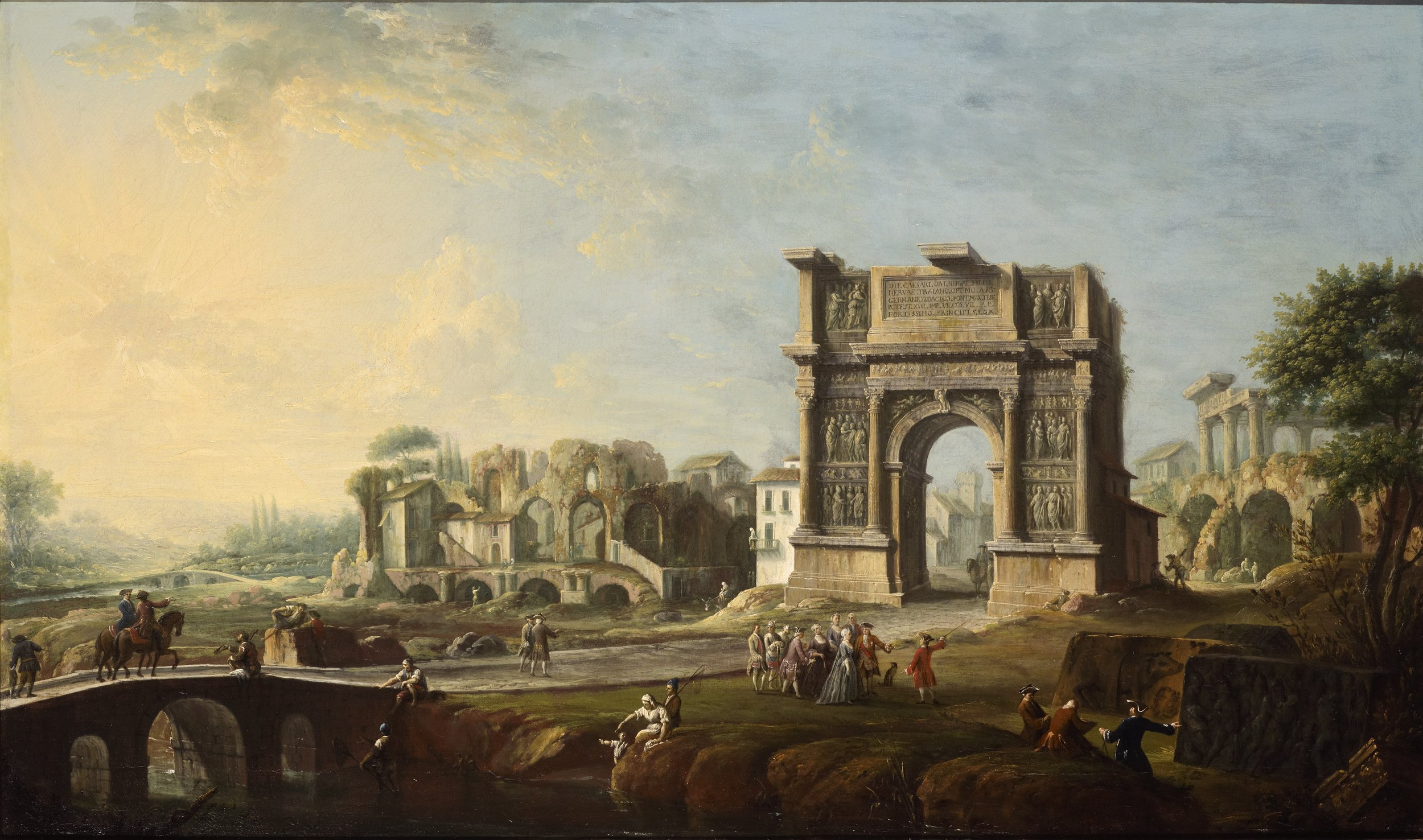ANTONIO JOLI
The Arch of Trajan at Benevento, with a group of visitors led by Maria Amalia of Saxony, Queen Consort of Naples and Sicily, and subsequently Spain, and the Marchese Bernardo Tanucci, an artist sketching in the foreground
(Modena c. 1700 – 1777 Naples)
Oil on canvas - 30 ½ x 51 ½ inches (77.5 x 131 cm)
PROVENANCE -
Private Collection, Italy, until 2010, purchased from Charles Beddington LTD from Museo Nacional del Prado.
Benevento is in Campania, 50 km inland from Naples. Originally called Maleventum, it was renamed Beneventum on becoming a Roman colony in 268 B.C., and by the end of the Republic it was one of the most prosperous cities in Italy. Under the Empire it was probably, after Capua, the largest city of southern Italy. Much of its significance must have been due to its position on the Via Appia at the junction of its two great branches, one, the Via Trajana, leading to Brindisi, the other to Taranto. It received repeated visits from Roman emperors, including Nero, Trajan and Septimius Severus.
Much the best known monument of classical Benevento is the Arch of Trajan, also known as the Porta Aurea, commissioned by the senate and people of Rome and constructed in Parian marble by Apollodorus of Damascus in 114. It is also depicted in an etching by Piranesi, and drawings in the British Museum by Willey Reveley (1700-1799) and Nicola Vianelli (1848), and a model of it is in the Gipsoteca of the University of Perugia. Fifteen metres high and straddling the Via Appia, it survives largely as shown here and is one of the best preserved Roman remains in the Campania and indeed one of the best preserved of all Roman triumphal arches. The reliefs on the side facing the city and on one wall of the passageway depict themes from Trajan's policy and work for Rome and Italy; those on the side toward the country and on the other wall of the passageway allude to his achievements abroad. Some of the reliefs are now in the British Museum.
The arch is here shown being admired by a group of sightseers led by Maria Amalia of Saxony (1724-1760), wife of Charles of Bourbon, King of Naples and Sicily and from 1759 King Charles III of Spain. She is accompanied by the Marchese Bernardo Tanucci (1698-1783), Charles’ immensely influential first minister. When the king left for Spain in 1759, his Italian thrones passed to his son Ferdinand III of Sicily and Ferdinand IV of Naples, then nine years old. As regent Tanucci became the virtual ruler of the two kingdoms, although his power waned after 1774 and he was dismissed in 1777. When the suppression of the Jesuits in 1767 resulted in papal excommunication, the monastery at Benevento was one of those seized by Tanucci in retaliation.
Tanucci is shown in several views incorporating depictions of notable events, including a number by Joli, notably his representations of The Departure of Charles of Bourbon for Spain in 1759 seen from the Land,1 his two versions of Charles of Bourbon installing his son Ferdinand as King of Naples and Sicily,2 and his three versions of A Game of Palla a Bracciale.3 He is also shown in the view by Pietro Fabris of The Festival in the Largo del Castello, Naples, on the Occasion of the Departure of charles of Bourbon for Spain in 1759.4 After the departure of Charles of Bourbon in 1759, Tanucci must have been responsible for royal commissions to Joli, who was working for the court from that year and settled definitively in Naples in 1762; Charles wrote to the minister in February 1764 expressing his eagerness to see two views by Joli which were about to arrive in Madrid.5
A slightly smaller version of this composition is among the paintings by Joli from the Bourbon royal collections at Caserta.6 That has entirely different figures, variations in the subsidiary buildings, and taller trees on the far right. Its apparently less distinguished quality, and the absence of the eminent visitors both suggest that it is of later date than this painting.
Sold to the Museo del Prado, Madrid.
1. R. Toledano, Antonio Joli, Turin, 2006, pp. 334-42, nos. N.XV.1-9, all illustrated.
2. Toledano 2006, pp. 346-7, nos. NXVII.1-2, both illustrated.
3. Toledano 2006, pp. 354-5, nos. N.XXI.1-3, illustrated.
4. N. Spinosa, Pittura napoletana del Settecento dal Rococò al Classicismo, Naples, 1987, p. 162, no. 304, fig. 402; N. Spinosa and L. Di Mauro, Vedute napoletane del Settecento, Naples, 1989, p. 200, no. 154, and p. 289, fig. 137; E. Bellucci in Importanti dipinti di veduta, ed. C. Naldi, Cocoon Art, Milan, 2008, pp. 18-21, illustrated in colour.
5. Toledano 2006, p. 32.
6. Toledano 2006, p. 386, no. N.XXXV, illustrated.


